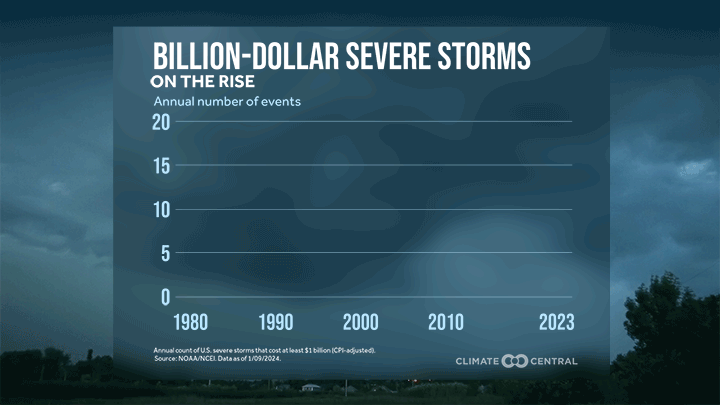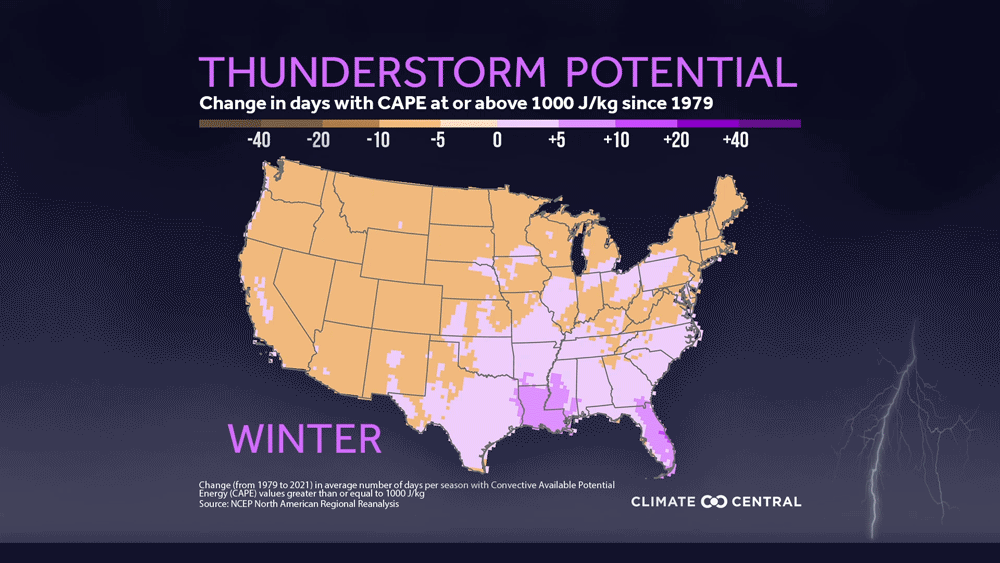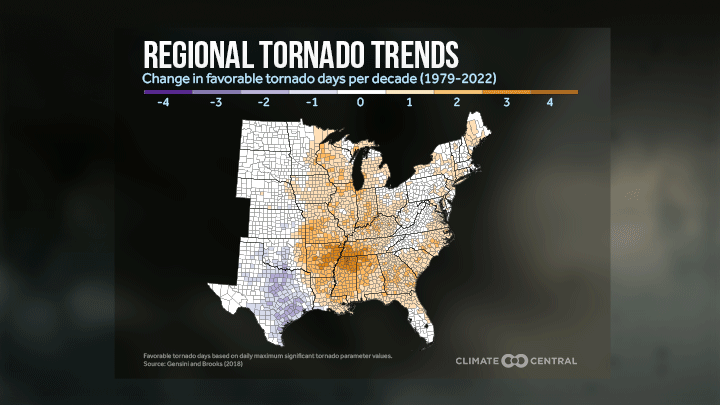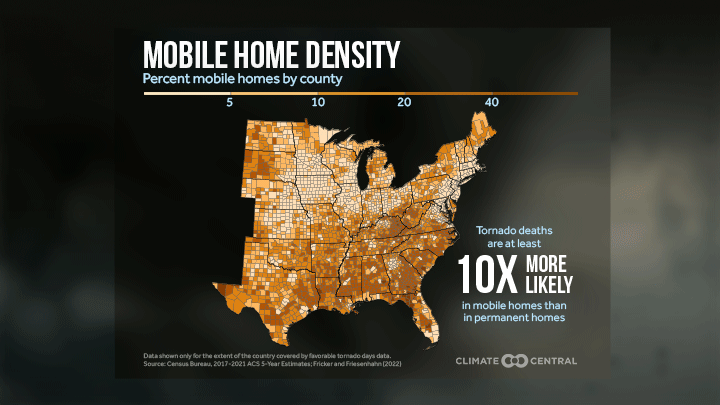Climate Matters•March 27, 2024
Severe Storm Super Hazards
KEY CONCEPTS
Severe storms account for half of all U.S. billion-dollar weather disasters since 1980.
The relationship between climate change and severe storms is a complex and active area of research. Certain conditions favorable to thunderstorms and tornadoes are occurring more often or expanding into historically less-active seasons and regions.
Nighttime tornadoes and large hail are among the most destructive and deadly severe storm hazards.
Areas east of the Mississippi River historically experience the most nighttime tornadoes. The proportion of U.S. tornado fatalities that occur at night has increased 20% since 1880.
Insured hail losses average from $8 billion to $14 billion per year in the U.S. Conditions conducive to large hail are projected to increase east of the Mississippi with future warming.
Download a .kml map: change in favorable tornado days (1979-2022)
Severe storms and climate change
Severe storms — thunderstorms that produce tornadoes, damaging winds (58 mph or higher), and/or large hail (at least one inch in diameter) — are destructive and deadly. They cause 200 deaths annually in the U.S. and account for half of all billion-dollar weather and climate disasters that have impacted the nation since 1980.
In 2023, the U.S. saw a record-shattering 19 billion-dollar severe storms — nearly 50% more than the previous record year (13 storms in 2020).

Most U.S. regions face severe weather risks — but especially in the South, Plains, and Ohio Valley from April through June.
Parts of Oklahoma, Kansas, Nebraska, Arkansas, Missouri, and Mississippi have seen the most severe weather watches over the last 20 years.
People living in mobile homes are particularly vulnerable during high wind events.

Severe storms are complex, localized, short-lived events with limited observational records or inconsistent reporting standards. And most climate models are too coarse to model the behavior of small-scale and short-lived convective events.
All of these factors make it challenging to detect severe storm trends and to link such trends to global climate change. The relationship between severe storms and climate change is an active area of research.
Here’s what we do know about changes in thunderstorms and resulting tornadoes:
Thunderstorm trends
Severe storms are more likely to form under certain conditions — including high wind shear and convective available potential energy (CAPE). Since 1979, parts of the eastern U.S. have seen up to 15 more days with high CAPE during spring and summer — prime time for thunderstorms.

But CAPE is just one of several important factors in severe storm formation and it’s unclear how other factors such as wind shear could respond to future warming. Long-term trends show that the frequency of severe and tornadic thunderstorms hasn’t changed significantly since 1979 over multiple U.S. regions.
These trends could shift in the future with continued warming. A recent study suggests that conditions favorable to severe thunderstorms could become about 5-20% more frequent per 1.8°F of warming. Whether these changing conditions will ultimately result in the formation of more severe storms remains an active area of research.
Supercells (severe thunderstorms with intense, rotating updrafts) are largely responsible for violent tornadoes (EF2+) in the U.S. A 2023 study projects a 6.6% increase in supercell frequency in the densely-populated eastern U.S. by the end of this century as a result of climate warming.
Tornado trends
When excluding the weakest events, the overall number of U.S. tornadoes each year hasn’t changed since 1970. But tornado activity has become concentrated in more frequent outbreaks (days with multiple tornadoes). Further, the frequency of U.S. tornado outbreaks is increasing faster for the most extreme outbreaks.
There is also evidence that tornadoes are getting more powerful in the U.S. and that fall tornado activity is increasing — especially in the Southeast. And “Tornado Alley” has shifted eastward since 1979, with increased tornadic activity observed in the South, Southeast, and Ohio Valley. There’s no clear connection between these observed trends and climate change, however.

Nighttime tornadoes
Some of the most deadly severe storm hazards occur at night — when tornadoes are difficult to observe and people may not be awake to receive and respond to warnings.
Nocturnal or nighttime tornadoes — which occur after local sunset and before local sunrise — are nearly twice as deadly as tornadoes that occur during the day. Since 1880, nighttime tornadoes have taken the lives of more than 6,700 people in the U.S. And the proportion of fatalities associated with nocturnal tornadoes has been steadily increasing.
Over the last 140 years, the proportion of all U.S. tornado fatalities that occur during daytime hours has decreased 20% whereas the percentage of nighttime tornado fatalities has increased 20%. Of these fatalities, those that occurred during overnight hours (local midnight to sunrise) increased fourfold.

From 1950 to 2019, over one-third of all tornado events occurred at night in states across the Midwest, South and Southeast. In Missouri, Mississippi, Kentucky, and Arkansas, this ratio surpassed 40%, and in Tennessee, nocturnal tornadoes accounted for over 45% of all tornado events.
The Mid-South and Southeast have large populations living in mobile homes — over 40% of all homes in some counties. Mobile homes are significantly more vulnerable to tornadic winds. As a result, tornado fatalities are at least 10 times more likely in mobile homes than in permanent homes (on both per-capita and per-housing unit levels).

Research suggests that the potential for nocturnal tornadoes may rise with future climate warming in response to projected increases in CAPE, as well as a likely strengthening and extension of the Great Plains low level jet. This fast-moving ribbon of air rapidly transports moisture and warmth from the Gulf of Mexico northward, helping to fuel and sustain nighttime severe storms in the Great Plains, Southeast, Mid-South, and Midwest.
Large hail
The most costly of severe-storm related hazards is large hail. Weather-sensitive economic sectors such as agriculture and aviation can be significantly impacted by hail. Hailstorms can also cause costly damage to property. Insured losses from hailstorms in the U.S. now average $8 billion to $14 billion per year. Hail can also cause injuries or even deaths, and the human safety risk increases with hail size.
As with other types of severe weather, limited and inconsistent observational hail records limit our ability to identify long-term trends.
A recent study did find an eastward shift and expansion of conditions conducive to large hail formation over much of the central and eastern portions of the U.S. from 1979 to 2017, with the largest increases in the Midwest.
The relationship between climate change and large hail is complex. Hail is formed when rain droplets are swept high into the atmosphere by thunderstorm updrafts into where the rain droplets freeze into ice in the very cold air. Hailstones then grow by colliding with supercooled liquid water drops that freeze onto the hailstone’s surface.
Climate warming can potentially foster more large hail by fueling stronger thunderstorm updrafts. Stronger updrafts suspend hail high within storms for longer, enabling them to grow and produce larger hailstones.
Another meteorological mechanism altered by climate change is the melting level height within a thunderstorm. A warmer atmosphere yields an increase of this melting level, which would bolster the melting of hailstones, but with greater effect yet on smaller-sized hailstones, whereas large hailstones can survive the trip through the storm’s zone of above-freezing temperatures.
A 2022 study found that, in response to future climate warming, spring hailstorms occurring in association with frontal systems in the central U.S. could yield a 114% increase in the occurrence of severe hail (1 to 2 inches in diameter) and a 145% increase in significant severe hail (at least 2 inches in diameter).
LOCAL STORY ANGLES
Is your community ready for severe weather?
NOAA’s Storm Prediction Center has active tornado watches and multi-day severe weather outlooks. For tips on how to stay informed on the threat for severe weather and step-by-step safety sheltering instructions for mobile/manufactured home residents, see the National Weather Service’s mobile home safety guidelines.
Tools for reporting on severe weather events and disasters
NOAA also has an interactive Damage Assessment Toolkit that can be used to map post-event damage assessment data for past severe storms in the U.S. Journalism schools and organizations provide advice for responsibly reporting on disasters, including focusing on safety, data, and cultural sensitivity. Be sure to check out Climate Central’s Extreme Weather Toolkit: Severe Weather (in English and Spanish).
CONTACT EXPERTS
Maria J. Molina, PhD (she/her)
Assistant Professor
University of Maryland
Relevant expertise: extending Earth system prediction, understanding genesis of extremes
Contact: mjmolina@umd.edu
*Available for interviews in Spanish
FIND EXPERTS
Submit a request to SciLine from the American Association for the Advancement of Science or to the Climate Data Concierge from Columbia University. These free services rapidly connect journalists to relevant scientific experts.
Browse maps of climate experts and services at regional NOAA, USDA, and Department of the Interior offices.
Explore databases such as 500 Women Scientists, BIPOC Climate and Energy Justice PhDs, and Diverse Sources to find and amplify diverse expert voices.
Reach out to your State Climate Office or the nearest Land-Grant University to connect with scientists, educators, and extension staff in your local area.
